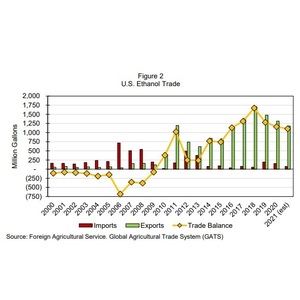Study: Ethanol industry strongly rebounded in 2021

February 22, 2022
BY Renewable Fuels Association
In 2021, the U.S. ethanol industry “recovered substantially” from pandemic conditions, with ethanol and gasoline use approaching pre-COVID-19 levels in the second half of the year, according to an analysis of the industry’s contribution to the United States economy, conducted by ABF Economics for the Renewable Fuels Association. Due to the combination of resurgent demand and higher values for ethanol and coproducts, the ethanol industry’s contribution to U.S. gross domestic product (GDP) in 2021 was the second-highest ever.
“Despite the persistence of COVID-19 and economic and regulatory challenges in 2021, the ethanol industry continued to make a significant contribution to the economy in terms of GDP, job creation, generation of tax revenue, and displacement of crude oil and petroleum products,” wrote study author John M. Urbanchuk, managing partner of ABF Economics. “Growth and expansion of the ethanol industry through the application of new technologies and feedstocks will enhance the industry’s position as the original creator of green jobs and will enable America to make further strides toward reducing greenhouse gas emissions and positively dealing with climate change.”
Advertisement
Advertisement
In 2021, more than 73,000 U.S. jobs were directly associated with the ethanol industry, which supported an additional 334,200 indirect and induced jobs across all sectors of the economy. The industry created $28.7 billion in household income and contributed just over $52 billion to gross domestic product. Compared to 2020, this represented a 55 percent increase in income generated and a 50 percent increase in the contribution to GDP.
“In more than 200 communities across the nation, ethanol biorefineries continued to serve as crucial drivers of economic growth in 2021,” RFA President and CEO Geoff Cooper said. “After weathering a perfect storm in 2020, the ethanol industry saw a healthy rebound in production, demand, and product values in 2021. The industry has entered 2022 in great shape, and we are bullish about the future.”
The new report also shows that the ethanol industry spent nearly $38 billion on raw materials, other inputs, and goods and services to produce ethanol during 2021, with corn purchases alone accounting for more than $30 billion. “Reflecting this, the ethanol industry continues to be a major source of support for agricultural output and farm income,” according to the study.
Advertisement
Advertisement
The report also provides a state-level breakdown of economic impacts and jobs supported by the ethanol industry in 2021.
Related Stories
The USDA significantly increased its estimate for 2025-’26 soybean oil use in biofuel production in its latest World Agricultural Supply and Demand Estimates report, released July 11. The outlook for soybean production was revised down.
The U.S. Energy Information Administration maintained its forecast for 2025 and 2026 biodiesel, renewable diesel and sustainable aviation fuel (SAF) production in its latest Short-Term Energy Outlook, released July 8.
XCF Global Inc. on July 10 shared its strategic plan to invest close to $1 billion in developing a network of SAF production facilities, expanding its U.S. footprint, and advancing its international growth strategy.
U.S. fuel ethanol capacity fell slightly in April, while biodiesel and renewable diesel capacity held steady, according to data released by the U.S. EIA on June 30. Feedstock consumption was down when compared to the previous month.
XCF Global Inc. on July 8 provided a production update on its flagship New Rise Reno facility, underscoring that the plant has successfully produced SAF, renewable diesel, and renewable naphtha during its initial ramp-up.
Upcoming Events










